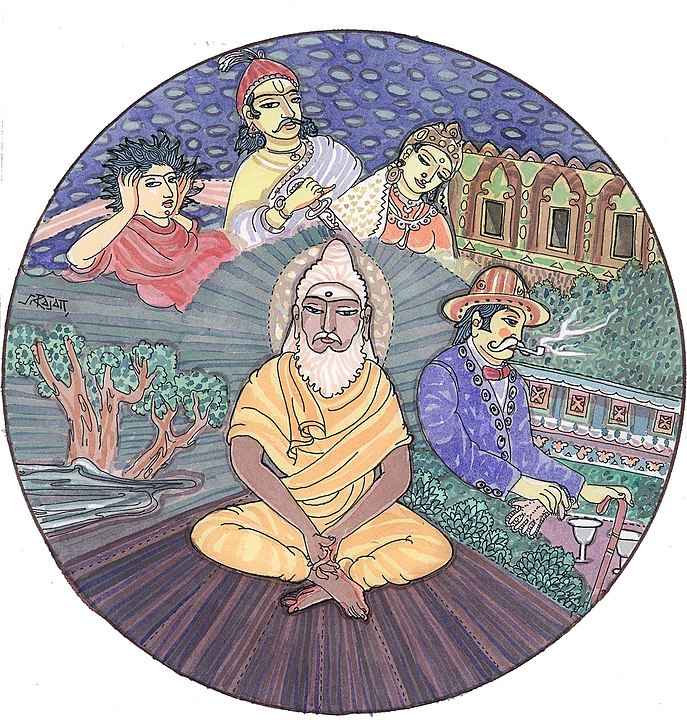
To compare Hinduism with The Church of Jesus Christ of Latter-day Saints, apparently, is like comparing a lake with the Pacific Ocean. Hinduism has over 1.1 billion adherents worldwide (15–16% of world’s population) while the Church of Jesus Christ has around 16 million members, and that’s about 0.2% of the world population. In other words, there are approximately 70 Hindus for each member of the Church of Jesus Christ.
This difference in numbers, however, can be explained by the fact that Hinduism has been around for about 4,000 years. Most scholars believe Hinduism formally started somewhere between 2300 B.C. and 1500 B.C. in the Indus Valley, near modern-day Pakistan. On the other hand, the restored Church of Jesus Christ was established in 1830, less than 200 years ago.
Many Hindus argue that their faith is timeless and has always existed. Similarly, members of The Church of Jesus Christ of Latter-day Saints believe that their church is a restoration of the same church established by Jesus Christ 2,000 years ago. They also believe that the same principles in which they believe now, the principles of the Gospel, are also eternal, and they were established on this planet at the time of Adam and Eve, a long time before the Savior was living on this earth, and even before historic Hinduism was established.

In short, these two religious traditions both claim that their beliefs are ancient, even eternal. The difference in their membership numbers shouldn’t reduce the value of comparing their beliefs and understand what they have in common and in what they differ. Clearly, many books could be written about this topic, while I will just list and compare briefly a few basic doctrines.
If we believe in one God, we should not be surprised to find many similarities among different religions. The Prophet Joseph Smith taught that “Mormonism is truth. … The first and fundamental principle of our holy religion is, that we believe that we have a right to embrace all, and every item of truth, without limitation or … being … prohibited by the creeds or superstitious notions of men.” And “If there is anything virtuous, lovely, or of good report or praiseworthy, we seek after these things.”
Karma and Law of Harvest

Hindus believe in a doctrine called Karma. Karma means action, work or deed, and it refers to the spiritual principle of cause and effect or the accumulation of results a person reaps from every act and thought, where the intent and actions of an individual are the cause that influence the future of that individual (effect). Good intent and good actions create good karma and happier rebirths, while bad intent and bad deeds create bad karma and bad rebirths.
In the doctrines of the The Church of Jesus Christ of Latter-day Saints we find a relatively similar principle as described in the book of scriptures called Doctrine & Covenants, where it says that:
“There is a law, irrevocably decreed in heaven before the foundations of this world, upon which all blessings are predicated. And when we obtain any blessing from God, it is by obedience to that law upon which it is predicated.” (D&C 130:20-21.)
In the New Testament of the Bible the same principle is expressed in Galatians 6:7
“Do not be deceived, God is not mocked; for whatever a man sows, this he will also reap”
This is the Law of the Harvest, that Jesus also taught in the New Testament. We reap what we sow.
The difference between Latter-day Saints and Hindus is that for Hindus the effects of the law of karma cannot be stopped or changed, and its effects are completely determined by a person’ actions. On the other hand, Latter-day Saints believe that the atonement of Jesus Christ has the power to intervene and change the inexorability of the Law of the Harvest. If it weren’t for the sacrifice of the Savior in our favor, we would reap the rewards of our actions without any external help, and we would be left to eternally pay the price of our sins.
Considering the difficulty of becoming perfect on our own, it’s not surprise that the Hindus, who don’t accept the mediating power of the Atonement of Jesus Christ, believe that individuals need to go through almost endless cycles of rebirths (saṃsāra) before they may obtain, eventually, their freedom from rebirth.
Hindus believe that they shouldn’t interfere with anybody else’s karma. Latter-day Saints believe in free agency, but the Savior taught that we should be involved in the lives of other people through doing good deeds and teaching the gospel. This is the doctrine of loving your neighbor as yourself.
Yoga and Oneness With God

Hinduism places great emphasis on Yoga (literally, union with God). Yoga is probably the most well known Hindu concept in the Western world, but it’s also one of the least understood. When people think of yoga, they think of Hatha Yoga, that focuses on physical postures, stretches, and movements.
However, there are other types of Yoga. The most important are Bhakti Yoga (the path of love and devotion), Karma Yoga (the path of right action), Rāja Yoga (the path of meditation), Jñāna Yoga (the path of wisdom). An individual may prefer one or some yogas over others, according to his or her inclination and understanding. They are all means to the same end.
The concept of being one with God is found also in many passages of the Bible and of the Latter-day Scriptures (Book of Mormon and Doctrine & Covenants).
For example, Jesus Christ said of those who would be part of His Church: “Be one; and if ye are not one ye are not mine” (D&C 38:27).
He also said, as recorded in the New Testament:
“Neither pray I for these alone, but for them also which shall believe on me through their word; That they all may be one; as thou, Father, art in me, and I in thee, that they also may be one in us: that the world may believe that thou hast sent me” (John 17:20–21).
The Latter-day Saints are also constantly invited to follow a path of love and devotion, of right actions, and of meditation. Regarding meditation, for example, in 1967 President David O. McKay said in a session of general conference:
“Meditation is the language of the soul. … It is a private devotion or spiritual exercise … it is a form of prayer and one of the most secret, most sacred doors through which we pass into the presence of the Lord. Jesus set the example for us.”
Spiritual Insights
Hinduism teaches an intuitive approach to truth, an immediate, sudden, and complete grasping of truth all at once, in one piece. They also teach that such truth is not found outside oneself, but within.
Latter-day Saints also believe in spiritual insights that transcend the mere powers of reason. Reason is a useful instrument in our lives, but it’s not enough to obtain a “testimony” or a spiritual knowledge of any truth, and therefore it needs to be complemented by faith, spiritual exertion, and rightful actions. Latter-day Saints believe that those moments of spiritual enlightenment are given to them by God, through the power of the Holy Ghost, when they have prepared to receive them.
Reincarnation and Pre-Mortal Existence

Hinduism teaches the doctrines of reincarnation. Reincarnation (also called rebirth or transmigration) is the concept that the non-physical essence of a living being starts a new life in a different physical form or body, after its biological death.
Many other similarly related doctrine have prevailed in almost every age. As a philosophical and theological concept, it can be found in some form or variation in Plato, the Essenes, Philo, Origen, Justin, the American Indians, and the Gnostics. Even more recent writers, such as I. H. Fichte, Herbart, Schopenhauer, Henri Bergson, and William James have proposed some variations of this concept that may resemble the belief of the members of The Church of Jesus Christ of Latter-day Saints in a pre-mortal existence.
All of these theories have some element in common with the Latter-day Saints idea of preexistence; but the LDS concept differs with all of these in the belief that the conscious individual spirit is an eternal and separate entity.
The Hindu doctrine of the eternal nature of soul avoids the implication of a separate individual unit, but stresses the World Soul idea, with both the spiritual and physical natures of man and woman coming from the same source. In other words, while man has a spiritual nature apart from the body that can be reborn into another body, it is not a self in the ultimate sense, but like the body, it is merely a part of the great World Soul.

The LDS doctrine of Pre-existence, on the other hand, is the belief that each individual human spirit existed before mortal conception, and that at some point before birth it entered into a body. This doctrine is different from the concept of reincarnation because it doesn’t allow for the idea of previous or future incarnation. There is no series of migrations of the soul to different bodies, but only one body and one eternal identity forever.
